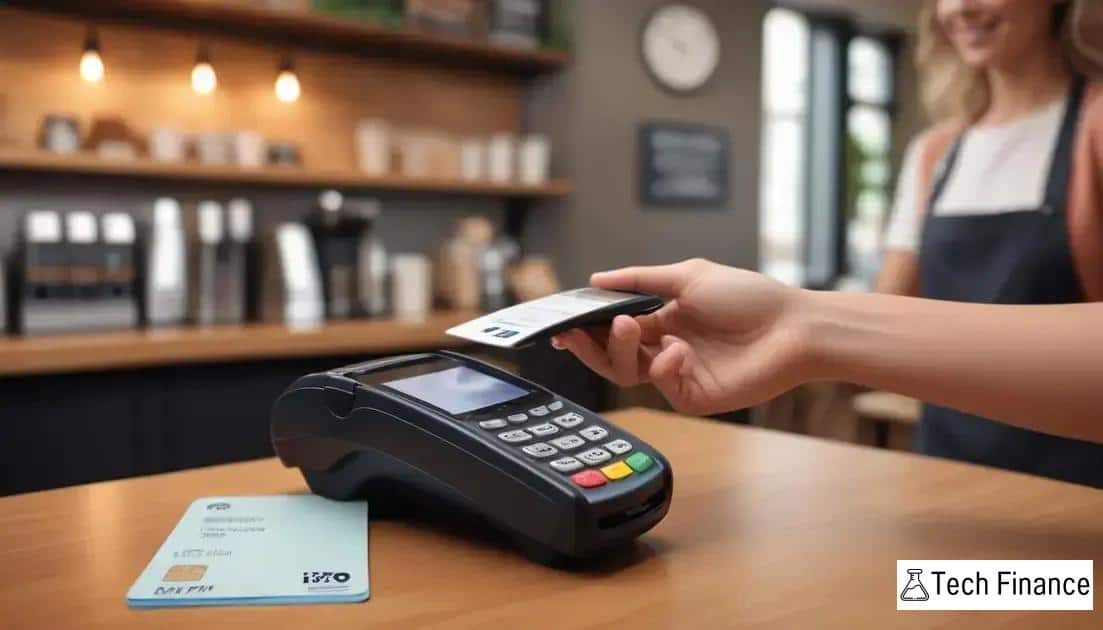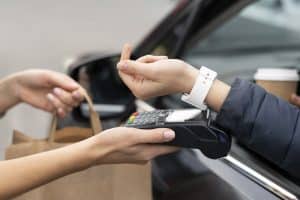Rise in usage of contactless credit transactions in the UK

Anúncios

Contactless credit transactions are changing how millions of people pay for everyday purchases across the UK. Whether you’re grabbing a coffee or shopping at the supermarket, tapping your card has likely become second nature.
Anúncios
But what’s fueling this shift in payment behavior, and how does it impact your day-to-day life?
This growing trend is more than just a matter of speed. It’s a reflection of how modern consumers value efficiency, hygiene, and convenience in financial interactions.
Anúncios
Let’s explore the landscape of contactless payments and how they’re shaping the future of spending.
Understanding Contactless Credit Transactions and Their Growing Impact
Understanding contactless credit transactions is more important than ever, as they now dominate how millions of UK consumers interact with money.
This payment method enables users to complete purchases by simply tapping a card or device, offering a frictionless alternative to traditional cash or chip-and-PIN methods.
Over 150 million contactless cards are currently in circulation in the UK, marking a historic milestone.
This widespread availability reflects the mainstream acceptance of contactless credit transactions as a trusted and secure form of payment for everyday use.
How the Technology Works
Each contactless card or mobile wallet uses Near Field Communication (NFC) to transmit encrypted payment data to a terminal.
The process takes only a few seconds and requires no PIN for purchases within a set limit, which has steadily increased to accommodate broader use.
This method allows consumers to keep their cards in their wallets or pay using smart devices, making transactions both faster and cleaner. This is especially beneficial in high-volume locations like supermarkets, cafés and public transport.
Key Advantages for Modern Consumers
The rising adoption of contactless credit transactions is closely tied to user experience.
- Speed and simplicity: Instant payments reduce wait times and improve the checkout experience.
- Secure encryption: Advanced security protocols protect cardholders from data theft.
- Hygiene and convenience: Less handling of cash or terminals supports public health and personal comfort.
With over £1 trillion in card transactions processed in the UK during 2024 alone, and a significant portion of them done through contactless methods, it’s clear this is not just a convenience, it’s a shift in payment culture.
Understanding how contactless credit transactions work equips users with the confidence to adopt them fully and responsibly. As this method becomes the new default, awareness and digital literacy become essential for navigating the modern economy.
The Rapid Growth of Contactless Credit Transactions Across the UK
The rise of contactless credit transactions in the UK marks a major transformation in how people pay. What began as a fast and hygienic alternative to cash has now become the preferred payment method for millions of consumers nationwide.
In 2024, UK cardholders made over £1 trillion in card transactions, with a substantial share processed via contactless methods. This surge is not accidental.
It is the result of technological improvements, growing consumer confidence, and a strong push toward a cashless society.
What Drives the Widespread Adoption of Contactless Technology
Several key factors are fueling this upward trend:
- Widespread card issuance: Over 150 million contactless cards are currently active in the UK, making the technology nearly universal.
- Retailer infrastructure: Most shops, restaurants, and public transport now support contactless terminals by default.
- Higher limits: Increased transaction limits allow users to rely on contactless even for medium-sized purchases.
Together, these factors have made contactless credit transactions not just a convenience but a standard part of everyday life.
Business and Consumer Impacts of Contactless Payment Growth
This shift is also transforming how businesses operate. Retailers who adopt contactless credit transactions benefit from shorter queues, higher transaction volume, and improved customer satisfaction.
For consumers, tap-to-pay has become second nature. The simplicity and speed of contactless credit transactions are now expected in most shopping environments. Many people no longer carry cash, relying entirely on cards and mobile wallets.
As digital habits continue to evolve, the growth of contactless credit transactions is set to accelerate.
With the addition of biometric security, real-time spending insights, and seamless mobile integration, this technology is shaping the future of payments across the UK.
Why Contactless Credit Transactions Offer a Better Way to Pay

Why Contactless Credit Transactions Offer a Better Way to Pay
Contactless credit transactions have redefined the purchasing experience by combining speed, security and comfort. A simple tap is all it takes to complete a payment, making this method ideal for daily routines and high-paced environments.
With over 150 million contactless cards currently in use across the UK, it’s clear that this form of payment has become a trusted part of everyday life.
Faster Payments, Fewer Hassles
One of the biggest draws of contactless credit transactions is how much time they save. Traditional payments often require inserting a card, entering a PIN or signing a receipt. With contactless, the process is instant.
This not only shortens queues in places like supermarkets or cafés, but also makes everyday purchases more convenient.
Small transactions, such as grabbing a coffee or a quick lunch, feel effortless. Users no longer need to dig for cash or handle coins. The simplicity of the tap-and-go experience encourages more frequent use, especially for low-value items.
Built-in Safety with Every Tap
Security is a top priority in the design of contactless credit transactions. Each payment uses encryption to protect sensitive data, reducing the risk of fraud.
Many banks also provide real-time alerts and fraud detection systems that add another layer of protection.
Another advantage is that consumers rarely have to remove their cards from wallets or purses. This lowers the chance of misplacing them and minimizes exposure to theft or loss.
A Cleaner and Smarter Option
Beyond speed and security, contactless credit transactions also contribute to better hygiene. With no need to handle cash or touch a keypad, users reduce physical contact during purchases.
This aspect became especially important in recent years, as health-conscious consumers looked for safer ways to shop.
The convenience and practicality of contactless payments have made them not just a trend, but a smarter, safer standard in the UK’s evolving payment landscape.
Challenges and concerns with contactless transactions
Although contactless credit transactions have improved convenience and speed, they also come with challenges that consumers should not overlook.
Understanding these risks allows users to take precautions and use the technology more confidently and responsibly.
Security Limitations and Consumer Caution
Even with built-in encryption, contactless credit transactions raise concerns about unauthorized use. If a card is lost or stolen, someone could make purchases without needing a PIN, especially for small-value items.
While many banks have safeguards and fraud alerts, protection levels vary depending on the institution.
There are also concerns about card skimming. Criminals may use hidden devices to read card data remotely, which makes some consumers hesitant.
Although such incidents are rare, the fear has led to calls for better user education and advanced anti-fraud measures.
Transaction limits can be another inconvenience. Most contactless payments have a spending cap, and for higher-value purchases, users must fall back on chip-and-PIN or digital alternatives.
This disrupts the seamless experience that contactless payments usually provide.
Awareness, Accessibility and Confidence
Many consumers still lack full understanding of how contactless credit transactions work. This can lead to hesitation, especially among those unfamiliar with newer technologies.
Financial institutions and retailers have a role to play in offering clear, accessible guidance to build user trust.
There is also the issue of inconsistent availability. Not all merchants accept contactless payments, which can cause frustration if customers expect to tap and go but must switch methods at the last minute.
This inconsistency highlights the need for broader infrastructure support.
As contactless payment options continue to evolve, staying informed is essential. Users who keep up with changes in limits, security features and device compatibility are better equipped to navigate the digital payment landscape with confidence.
Future trends in contactless payment technology

As digital finance advances, contactless credit transactions are evolving into smarter and more secure solutions. Emerging technologies are shaping the way people make payments, blending speed with personalization and global accessibility.
Biometric Authentication Will Boost Trust and Security
Biometric features such as fingerprint scans and facial recognition are being integrated into payment systems. These methods provide seamless, secure ways to verify transactions without sacrificing speed.
Consumers are more likely to trust contactless credit transactions when extra layers of protection are built in.
This shift also reduces the need for physical cards, as devices become the primary tool for secure identification at checkout points.
Mobile Wallets Are Becoming the New Normal
Mobile wallets are transforming the way users manage their money. By storing multiple cards and financial tools in one app, they streamline contactless credit transactions.
A single tap from a smartphone is now enough to pay, monitor expenses, and earn rewards instantly.
The convenience of having all payment methods in one place makes mobile wallets especially appealing to younger generations and busy consumers.
Global Expansion Will Drive Financial Inclusion
In emerging economies, the adoption of contactless credit transactions is improving access to digital financial services. More businesses are equipping themselves with contactless-capable terminals, helping reach underbanked populations.
This growth supports financial inclusion and accelerates the global shift toward digital, touch-free payments.
Smart Features Will Enhance Everyday Use
Future updates will bring tools like automated bill splitting, real-time spending alerts and personalized budgeting suggestions. These innovations will elevate contactless credit transactions from a quick convenience to a fully adaptive financial experience.
To make the most of these changes, consumers are turning to digital banking solutions that support integrated, secure, and responsive payment options.
Learn more about how this financial evolution works in our full guide on online banking, and discover how it connects to the future of contactless technology.
Final Thoughts: The Role of Contactless Credit Transactions in the UK’s Financial Future
Contactless credit transactions are now a fundamental part of how people pay across the UK. They offer unmatched speed, convenience and hygiene, changing the way we think about everyday purchases.
With a simple tap, consumers gain access to a seamless and secure payment experience.
According to UK Finance, over 150 million contactless cards are currently active in the UK. This shows how deeply contactless credit transactions have become embedded in daily life.
The adoption is growing steadily as more retailers and consumers embrace the tap-and-go experience.
In 2024 alone, the total value of card transactions in the UK surpassed £1 trillion, as reported by UK Finance. A significant share of this came from contactless credit transactions, reinforcing their importance in a digital-first economy.
Whether you are shopping, commuting or dining out, contactless credit transactions provide a faster, safer and more reliable way to pay.
As biometric features and smart wallets continue to evolve, this method is set to become even more secure and efficient.
Staying informed about this transformation is essential for consumers and businesses alike. Embracing contactless credit transactions today means staying ahead in the future of payments.
To explore the most recent data and insights, visit UK Finance’s official website.
FAQ – Frequently Asked Questions About Contactless Payments
What are contactless payments?
Contactless payments allow users to make transactions by simply tapping their card or mobile device on a compatible terminal, providing a quick and convenient payment method.
Are contactless payments secure?
Yes, contactless payments use encryption and often incorporate security features like fraud detection, but it’s essential for users to be aware of potential risks.
What limits exist for contactless transactions?
Many retailers set a maximum transaction limit for contactless payments. This means larger purchases may require traditional payment methods.
How is technology evolving in contactless payments?
Future trends include the adoption of biometric authentication, like fingerprints and facial recognition, and the rise of mobile wallets that enhance user convenience and security.
Liked the article?





